Financial Decision Making Report: Financial Analysis of Panini Ltd
VerifiedAdded on 2023/06/05
|10
|3157
|97
Report
AI Summary
This report provides a comprehensive analysis of financial decision-making within the context of Panini Ltd. It begins with an introduction to financial decision-making, emphasizing its importance in investment, financing, and operational choices. The report is divided into two main tasks. Task 1 delves into accounting and financial functions, outlining their roles and duties within a business organization, and explores various sources of finance, differentiating between internal and external options, specifically equity and debt. Task 2 focuses on financial ratio analysis, calculating and interpreting key ratios such as gross profit margin, operating profit margin, return on capital employed, current ratio, quick ratio, inventory turnover, receivable collection period, and payable payment period for Panini Ltd, offering insights into the company's efficiency and financial health. The report concludes with a summary of findings and references used.

Financial Decision
Making
Making
Paraphrase This Document
Need a fresh take? Get an instant paraphrase of this document with our AI Paraphraser
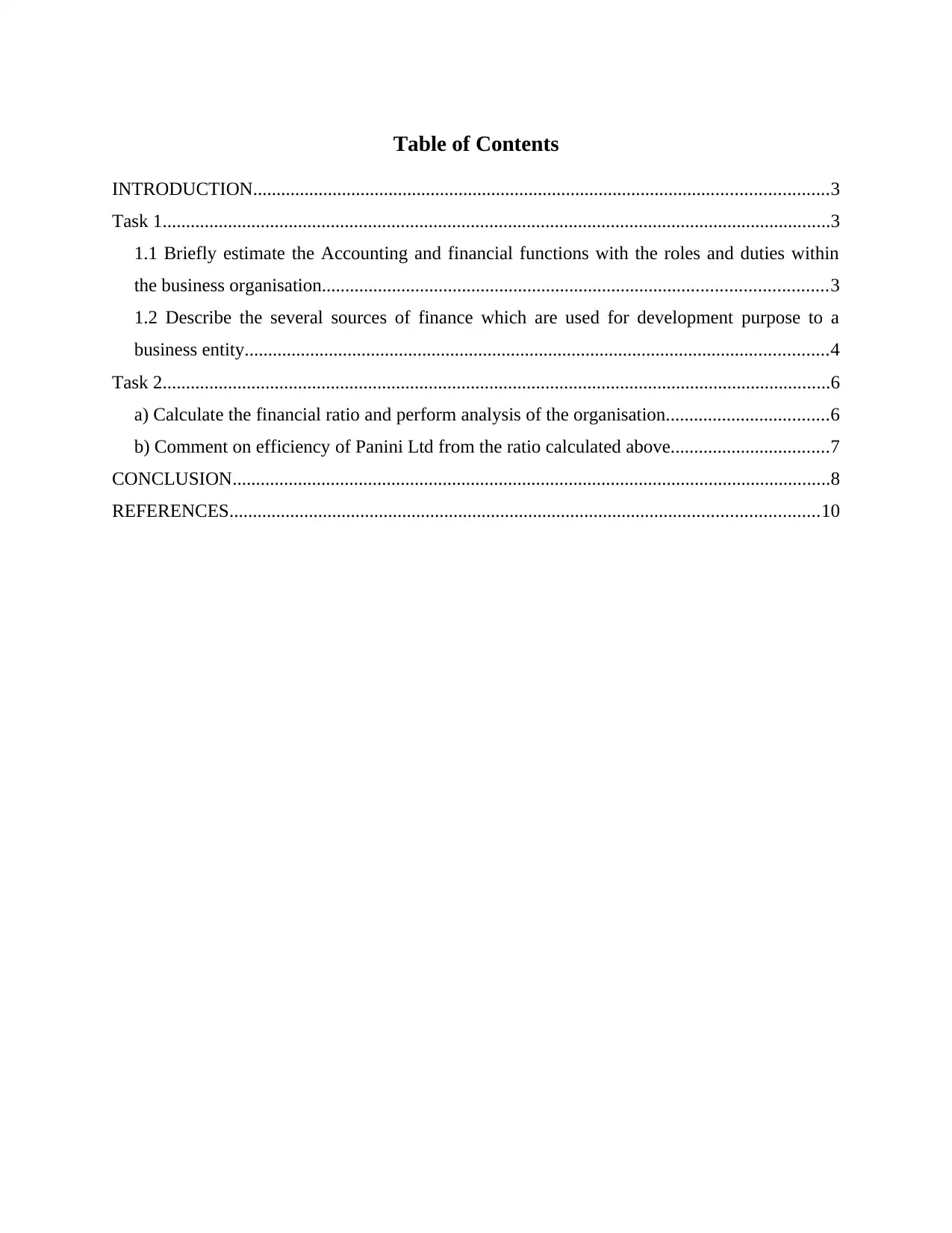
Table of Contents
INTRODUCTION...........................................................................................................................3
Task 1...............................................................................................................................................3
1.1 Briefly estimate the Accounting and financial functions with the roles and duties within
the business organisation............................................................................................................3
1.2 Describe the several sources of finance which are used for development purpose to a
business entity.............................................................................................................................4
Task 2...............................................................................................................................................6
a) Calculate the financial ratio and perform analysis of the organisation...................................6
b) Comment on efficiency of Panini Ltd from the ratio calculated above..................................7
CONCLUSION................................................................................................................................8
REFERENCES..............................................................................................................................10
INTRODUCTION...........................................................................................................................3
Task 1...............................................................................................................................................3
1.1 Briefly estimate the Accounting and financial functions with the roles and duties within
the business organisation............................................................................................................3
1.2 Describe the several sources of finance which are used for development purpose to a
business entity.............................................................................................................................4
Task 2...............................................................................................................................................6
a) Calculate the financial ratio and perform analysis of the organisation...................................6
b) Comment on efficiency of Panini Ltd from the ratio calculated above..................................7
CONCLUSION................................................................................................................................8
REFERENCES..............................................................................................................................10
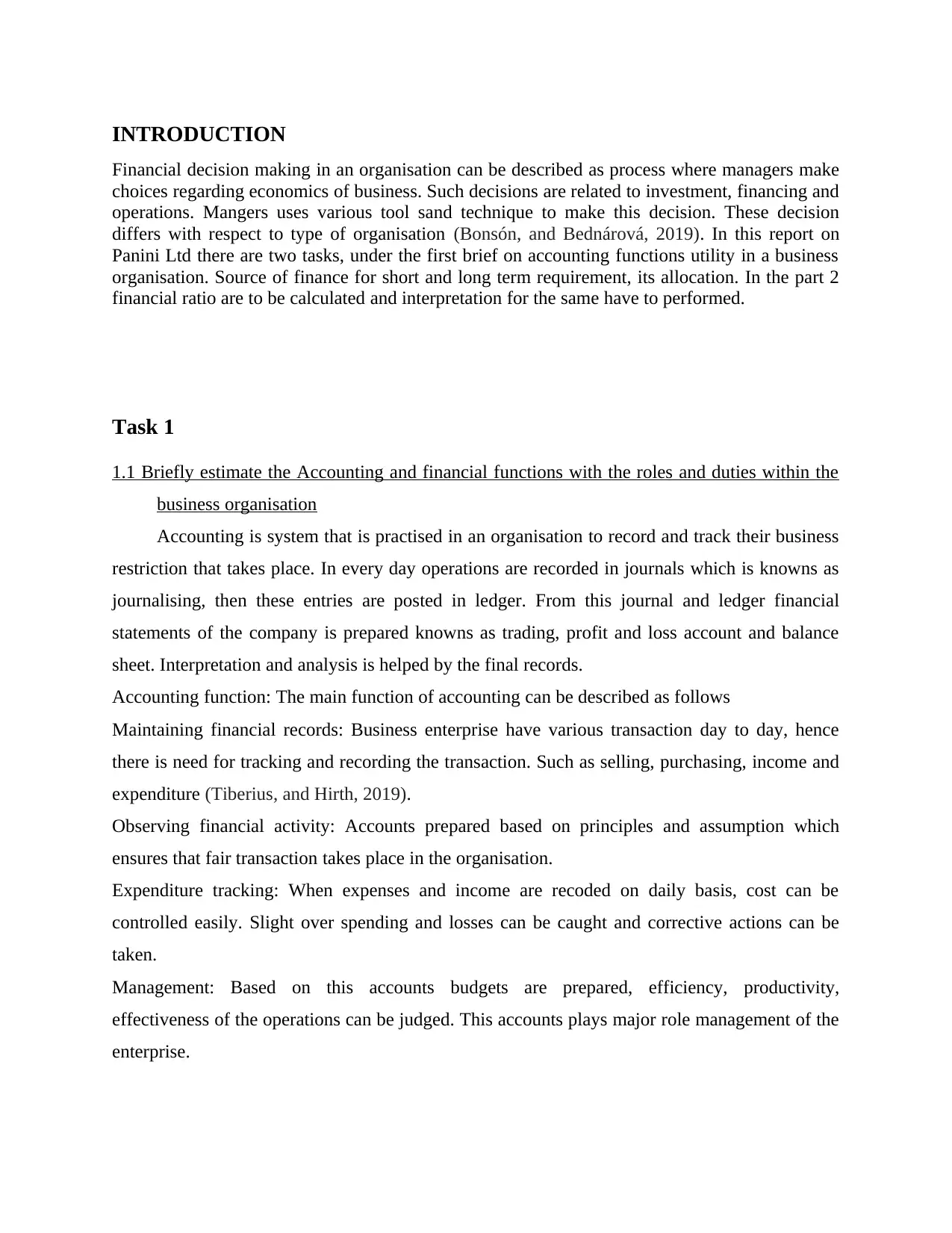
INTRODUCTION
Financial decision making in an organisation can be described as process where managers make
choices regarding economics of business. Such decisions are related to investment, financing and
operations. Mangers uses various tool sand technique to make this decision. These decision
differs with respect to type of organisation (Bonsón, and Bednárová, 2019). In this report on
Panini Ltd there are two tasks, under the first brief on accounting functions utility in a business
organisation. Source of finance for short and long term requirement, its allocation. In the part 2
financial ratio are to be calculated and interpretation for the same have to performed.
Task 1
1.1 Briefly estimate the Accounting and financial functions with the roles and duties within the
business organisation
Accounting is system that is practised in an organisation to record and track their business
restriction that takes place. In every day operations are recorded in journals which is knowns as
journalising, then these entries are posted in ledger. From this journal and ledger financial
statements of the company is prepared knowns as trading, profit and loss account and balance
sheet. Interpretation and analysis is helped by the final records.
Accounting function: The main function of accounting can be described as follows
Maintaining financial records: Business enterprise have various transaction day to day, hence
there is need for tracking and recording the transaction. Such as selling, purchasing, income and
expenditure (Tiberius, and Hirth, 2019).
Observing financial activity: Accounts prepared based on principles and assumption which
ensures that fair transaction takes place in the organisation.
Expenditure tracking: When expenses and income are recoded on daily basis, cost can be
controlled easily. Slight over spending and losses can be caught and corrective actions can be
taken.
Management: Based on this accounts budgets are prepared, efficiency, productivity,
effectiveness of the operations can be judged. This accounts plays major role management of the
enterprise.
Financial decision making in an organisation can be described as process where managers make
choices regarding economics of business. Such decisions are related to investment, financing and
operations. Mangers uses various tool sand technique to make this decision. These decision
differs with respect to type of organisation (Bonsón, and Bednárová, 2019). In this report on
Panini Ltd there are two tasks, under the first brief on accounting functions utility in a business
organisation. Source of finance for short and long term requirement, its allocation. In the part 2
financial ratio are to be calculated and interpretation for the same have to performed.
Task 1
1.1 Briefly estimate the Accounting and financial functions with the roles and duties within the
business organisation
Accounting is system that is practised in an organisation to record and track their business
restriction that takes place. In every day operations are recorded in journals which is knowns as
journalising, then these entries are posted in ledger. From this journal and ledger financial
statements of the company is prepared knowns as trading, profit and loss account and balance
sheet. Interpretation and analysis is helped by the final records.
Accounting function: The main function of accounting can be described as follows
Maintaining financial records: Business enterprise have various transaction day to day, hence
there is need for tracking and recording the transaction. Such as selling, purchasing, income and
expenditure (Tiberius, and Hirth, 2019).
Observing financial activity: Accounts prepared based on principles and assumption which
ensures that fair transaction takes place in the organisation.
Expenditure tracking: When expenses and income are recoded on daily basis, cost can be
controlled easily. Slight over spending and losses can be caught and corrective actions can be
taken.
Management: Based on this accounts budgets are prepared, efficiency, productivity,
effectiveness of the operations can be judged. This accounts plays major role management of the
enterprise.
⊘ This is a preview!⊘
Do you want full access?
Subscribe today to unlock all pages.

Trusted by 1+ million students worldwide
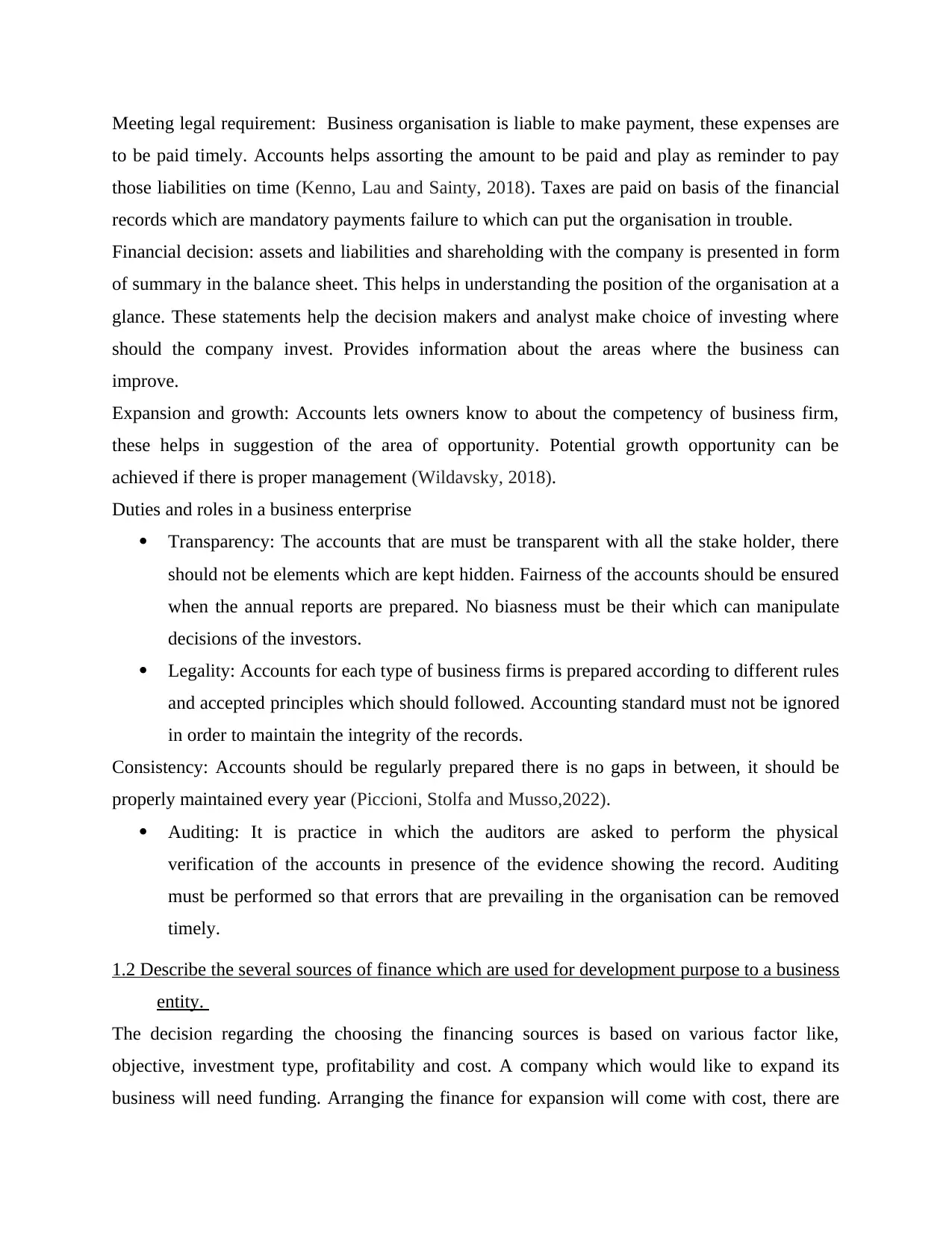
Meeting legal requirement: Business organisation is liable to make payment, these expenses are
to be paid timely. Accounts helps assorting the amount to be paid and play as reminder to pay
those liabilities on time (Kenno, Lau and Sainty, 2018). Taxes are paid on basis of the financial
records which are mandatory payments failure to which can put the organisation in trouble.
Financial decision: assets and liabilities and shareholding with the company is presented in form
of summary in the balance sheet. This helps in understanding the position of the organisation at a
glance. These statements help the decision makers and analyst make choice of investing where
should the company invest. Provides information about the areas where the business can
improve.
Expansion and growth: Accounts lets owners know to about the competency of business firm,
these helps in suggestion of the area of opportunity. Potential growth opportunity can be
achieved if there is proper management (Wildavsky, 2018).
Duties and roles in a business enterprise
Transparency: The accounts that are must be transparent with all the stake holder, there
should not be elements which are kept hidden. Fairness of the accounts should be ensured
when the annual reports are prepared. No biasness must be their which can manipulate
decisions of the investors.
Legality: Accounts for each type of business firms is prepared according to different rules
and accepted principles which should followed. Accounting standard must not be ignored
in order to maintain the integrity of the records.
Consistency: Accounts should be regularly prepared there is no gaps in between, it should be
properly maintained every year (Piccioni, Stolfa and Musso,2022).
Auditing: It is practice in which the auditors are asked to perform the physical
verification of the accounts in presence of the evidence showing the record. Auditing
must be performed so that errors that are prevailing in the organisation can be removed
timely.
1.2 Describe the several sources of finance which are used for development purpose to a business
entity.
The decision regarding the choosing the financing sources is based on various factor like,
objective, investment type, profitability and cost. A company which would like to expand its
business will need funding. Arranging the finance for expansion will come with cost, there are
to be paid timely. Accounts helps assorting the amount to be paid and play as reminder to pay
those liabilities on time (Kenno, Lau and Sainty, 2018). Taxes are paid on basis of the financial
records which are mandatory payments failure to which can put the organisation in trouble.
Financial decision: assets and liabilities and shareholding with the company is presented in form
of summary in the balance sheet. This helps in understanding the position of the organisation at a
glance. These statements help the decision makers and analyst make choice of investing where
should the company invest. Provides information about the areas where the business can
improve.
Expansion and growth: Accounts lets owners know to about the competency of business firm,
these helps in suggestion of the area of opportunity. Potential growth opportunity can be
achieved if there is proper management (Wildavsky, 2018).
Duties and roles in a business enterprise
Transparency: The accounts that are must be transparent with all the stake holder, there
should not be elements which are kept hidden. Fairness of the accounts should be ensured
when the annual reports are prepared. No biasness must be their which can manipulate
decisions of the investors.
Legality: Accounts for each type of business firms is prepared according to different rules
and accepted principles which should followed. Accounting standard must not be ignored
in order to maintain the integrity of the records.
Consistency: Accounts should be regularly prepared there is no gaps in between, it should be
properly maintained every year (Piccioni, Stolfa and Musso,2022).
Auditing: It is practice in which the auditors are asked to perform the physical
verification of the accounts in presence of the evidence showing the record. Auditing
must be performed so that errors that are prevailing in the organisation can be removed
timely.
1.2 Describe the several sources of finance which are used for development purpose to a business
entity.
The decision regarding the choosing the financing sources is based on various factor like,
objective, investment type, profitability and cost. A company which would like to expand its
business will need funding. Arranging the finance for expansion will come with cost, there are
Paraphrase This Document
Need a fresh take? Get an instant paraphrase of this document with our AI Paraphraser
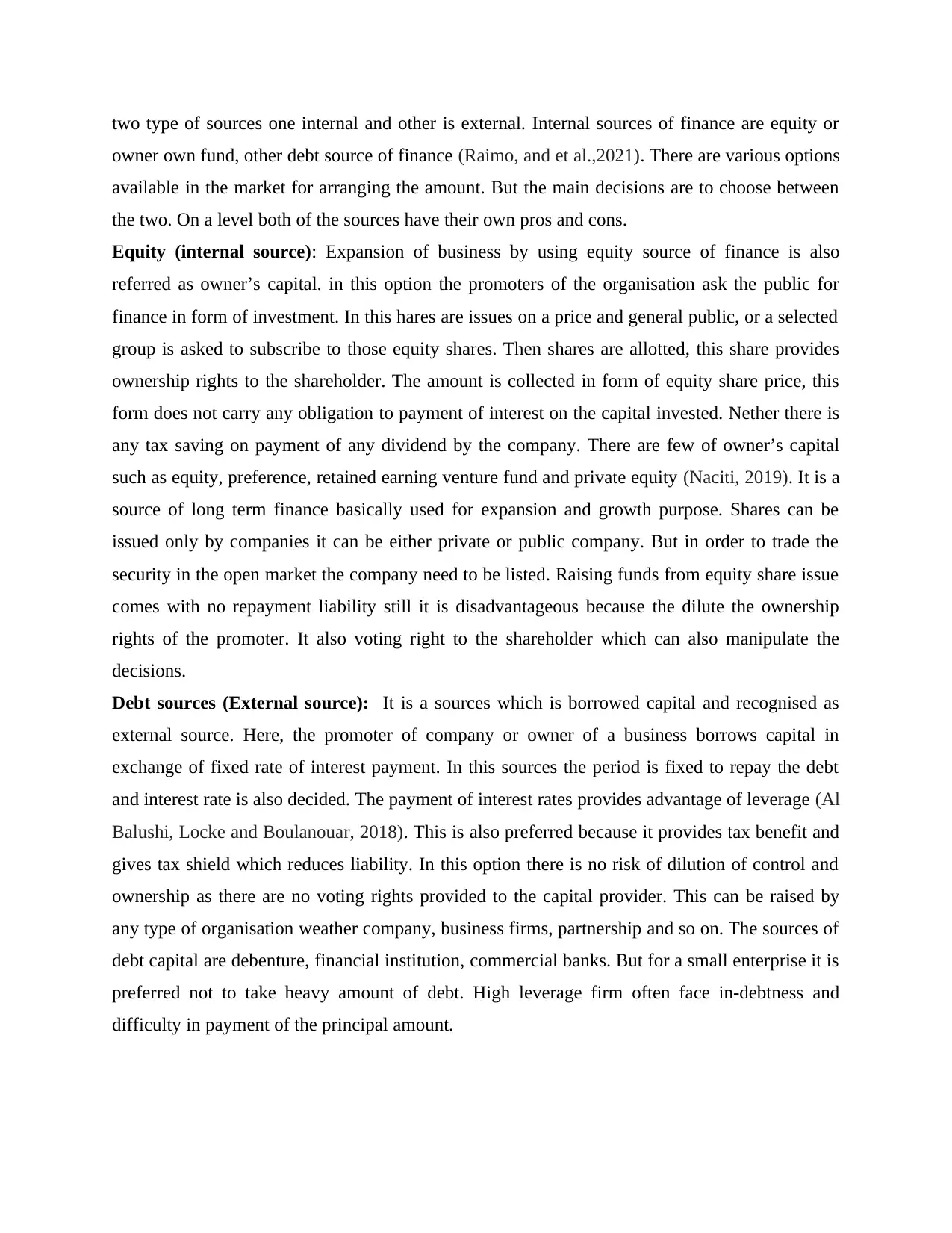
two type of sources one internal and other is external. Internal sources of finance are equity or
owner own fund, other debt source of finance (Raimo, and et al.,2021). There are various options
available in the market for arranging the amount. But the main decisions are to choose between
the two. On a level both of the sources have their own pros and cons.
Equity (internal source): Expansion of business by using equity source of finance is also
referred as owner’s capital. in this option the promoters of the organisation ask the public for
finance in form of investment. In this hares are issues on a price and general public, or a selected
group is asked to subscribe to those equity shares. Then shares are allotted, this share provides
ownership rights to the shareholder. The amount is collected in form of equity share price, this
form does not carry any obligation to payment of interest on the capital invested. Nether there is
any tax saving on payment of any dividend by the company. There are few of owner’s capital
such as equity, preference, retained earning venture fund and private equity (Naciti, 2019). It is a
source of long term finance basically used for expansion and growth purpose. Shares can be
issued only by companies it can be either private or public company. But in order to trade the
security in the open market the company need to be listed. Raising funds from equity share issue
comes with no repayment liability still it is disadvantageous because the dilute the ownership
rights of the promoter. It also voting right to the shareholder which can also manipulate the
decisions.
Debt sources (External source): It is a sources which is borrowed capital and recognised as
external source. Here, the promoter of company or owner of a business borrows capital in
exchange of fixed rate of interest payment. In this sources the period is fixed to repay the debt
and interest rate is also decided. The payment of interest rates provides advantage of leverage (Al
Balushi, Locke and Boulanouar, 2018). This is also preferred because it provides tax benefit and
gives tax shield which reduces liability. In this option there is no risk of dilution of control and
ownership as there are no voting rights provided to the capital provider. This can be raised by
any type of organisation weather company, business firms, partnership and so on. The sources of
debt capital are debenture, financial institution, commercial banks. But for a small enterprise it is
preferred not to take heavy amount of debt. High leverage firm often face in-debtness and
difficulty in payment of the principal amount.
owner own fund, other debt source of finance (Raimo, and et al.,2021). There are various options
available in the market for arranging the amount. But the main decisions are to choose between
the two. On a level both of the sources have their own pros and cons.
Equity (internal source): Expansion of business by using equity source of finance is also
referred as owner’s capital. in this option the promoters of the organisation ask the public for
finance in form of investment. In this hares are issues on a price and general public, or a selected
group is asked to subscribe to those equity shares. Then shares are allotted, this share provides
ownership rights to the shareholder. The amount is collected in form of equity share price, this
form does not carry any obligation to payment of interest on the capital invested. Nether there is
any tax saving on payment of any dividend by the company. There are few of owner’s capital
such as equity, preference, retained earning venture fund and private equity (Naciti, 2019). It is a
source of long term finance basically used for expansion and growth purpose. Shares can be
issued only by companies it can be either private or public company. But in order to trade the
security in the open market the company need to be listed. Raising funds from equity share issue
comes with no repayment liability still it is disadvantageous because the dilute the ownership
rights of the promoter. It also voting right to the shareholder which can also manipulate the
decisions.
Debt sources (External source): It is a sources which is borrowed capital and recognised as
external source. Here, the promoter of company or owner of a business borrows capital in
exchange of fixed rate of interest payment. In this sources the period is fixed to repay the debt
and interest rate is also decided. The payment of interest rates provides advantage of leverage (Al
Balushi, Locke and Boulanouar, 2018). This is also preferred because it provides tax benefit and
gives tax shield which reduces liability. In this option there is no risk of dilution of control and
ownership as there are no voting rights provided to the capital provider. This can be raised by
any type of organisation weather company, business firms, partnership and so on. The sources of
debt capital are debenture, financial institution, commercial banks. But for a small enterprise it is
preferred not to take heavy amount of debt. High leverage firm often face in-debtness and
difficulty in payment of the principal amount.

Task 2
a) Calculate the financial ratio and perform analysis of the organisation.
Gross profit margin: Gross profit/ Net sales * 100
2018: 3500/ 10000 * 100 = 35%
2019: 3265/ 11500 * 100 = 28.39%
Operating profit margin: Operating profit/ Net sales * 100
2018: 2765/ 10000* 100 = 27.65%
2019: 2305/ 11500* 100 = 20.04%
Return on capital employed: Earnings before interest and tax/ (Share equity + Long term
liabilities) * 100
2018: 2765/ 8755= 31.58%
2019: 2305/ 10211* 100 = 22.57%
Current Ratio: Current assets/ Current liabilities
2018: 1175/ 970 = 1.211: 1
2019: 2110/ 512 = 4.12: 1
Quick Ratio: (Current assets – Inventory) / Current liabilities
2018: 1175 – 350/ 970 = 0.85: 1
2019: 2110 – 675/ 512 = 2.80: 1
Inventory turnover days: Cost of goods sold / average inventory (Batool, Awan, and Chughtai,
2021)
2018: 6500 / 512 = 12.6 times
2019: 8235 / 512 = 16.08 times
Receivable collection period: 365 / Sales on credit / accounts receivable
2018: 365 / 10000 / 760 = 27.74 days
2019: 365 / 11500 / 1340 = 42.54 days
Payable payment period: 365/ cost of sales / Trade payable
a) Calculate the financial ratio and perform analysis of the organisation.
Gross profit margin: Gross profit/ Net sales * 100
2018: 3500/ 10000 * 100 = 35%
2019: 3265/ 11500 * 100 = 28.39%
Operating profit margin: Operating profit/ Net sales * 100
2018: 2765/ 10000* 100 = 27.65%
2019: 2305/ 11500* 100 = 20.04%
Return on capital employed: Earnings before interest and tax/ (Share equity + Long term
liabilities) * 100
2018: 2765/ 8755= 31.58%
2019: 2305/ 10211* 100 = 22.57%
Current Ratio: Current assets/ Current liabilities
2018: 1175/ 970 = 1.211: 1
2019: 2110/ 512 = 4.12: 1
Quick Ratio: (Current assets – Inventory) / Current liabilities
2018: 1175 – 350/ 970 = 0.85: 1
2019: 2110 – 675/ 512 = 2.80: 1
Inventory turnover days: Cost of goods sold / average inventory (Batool, Awan, and Chughtai,
2021)
2018: 6500 / 512 = 12.6 times
2019: 8235 / 512 = 16.08 times
Receivable collection period: 365 / Sales on credit / accounts receivable
2018: 365 / 10000 / 760 = 27.74 days
2019: 365 / 11500 / 1340 = 42.54 days
Payable payment period: 365/ cost of sales / Trade payable
⊘ This is a preview!⊘
Do you want full access?
Subscribe today to unlock all pages.

Trusted by 1+ million students worldwide
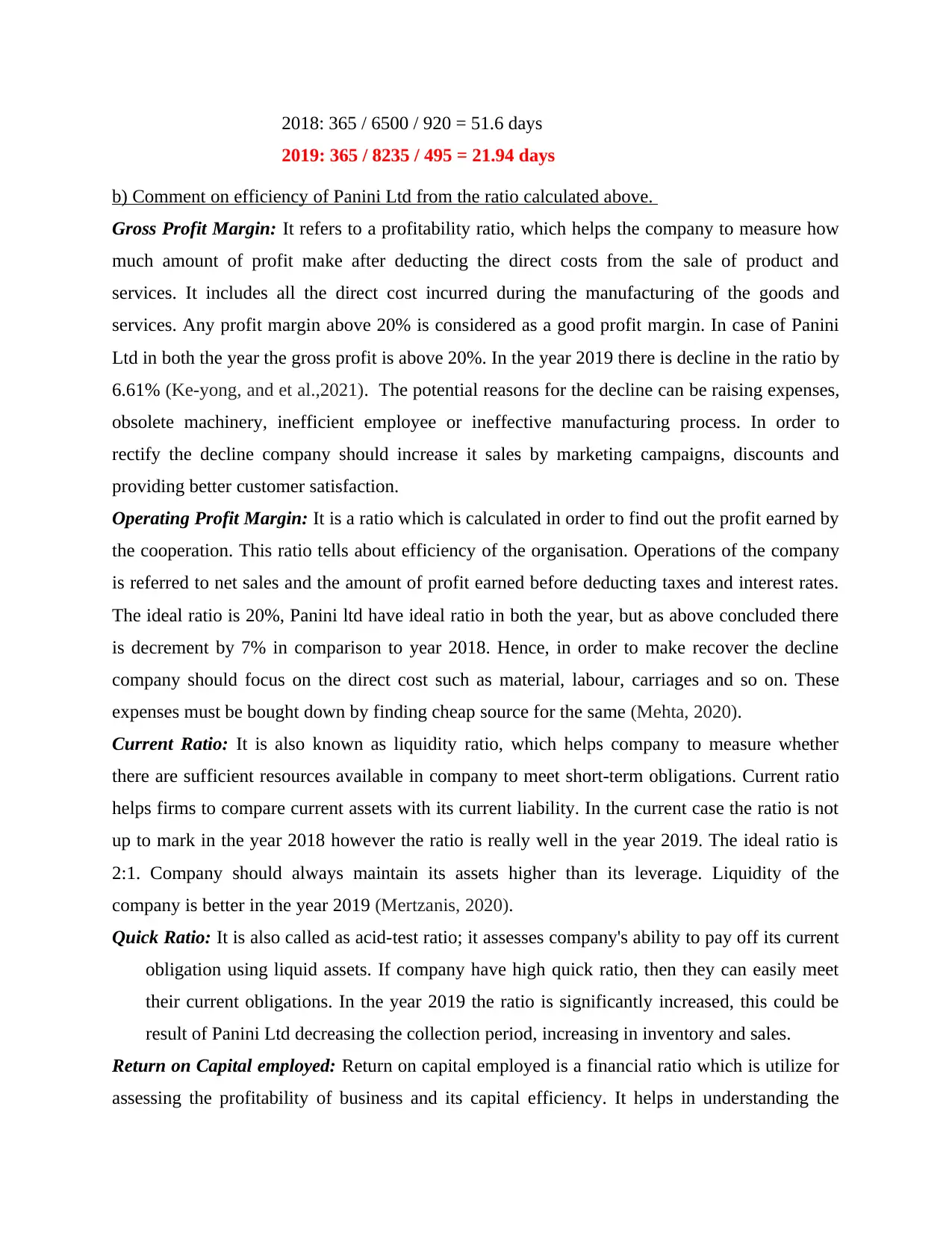
2018: 365 / 6500 / 920 = 51.6 days
2019: 365 / 8235 / 495 = 21.94 days
b) Comment on efficiency of Panini Ltd from the ratio calculated above.
Gross Profit Margin: It refers to a profitability ratio, which helps the company to measure how
much amount of profit make after deducting the direct costs from the sale of product and
services. It includes all the direct cost incurred during the manufacturing of the goods and
services. Any profit margin above 20% is considered as a good profit margin. In case of Panini
Ltd in both the year the gross profit is above 20%. In the year 2019 there is decline in the ratio by
6.61% (Ke-yong, and et al.,2021). The potential reasons for the decline can be raising expenses,
obsolete machinery, inefficient employee or ineffective manufacturing process. In order to
rectify the decline company should increase it sales by marketing campaigns, discounts and
providing better customer satisfaction.
Operating Profit Margin: It is a ratio which is calculated in order to find out the profit earned by
the cooperation. This ratio tells about efficiency of the organisation. Operations of the company
is referred to net sales and the amount of profit earned before deducting taxes and interest rates.
The ideal ratio is 20%, Panini ltd have ideal ratio in both the year, but as above concluded there
is decrement by 7% in comparison to year 2018. Hence, in order to make recover the decline
company should focus on the direct cost such as material, labour, carriages and so on. These
expenses must be bought down by finding cheap source for the same (Mehta, 2020).
Current Ratio: It is also known as liquidity ratio, which helps company to measure whether
there are sufficient resources available in company to meet short-term obligations. Current ratio
helps firms to compare current assets with its current liability. In the current case the ratio is not
up to mark in the year 2018 however the ratio is really well in the year 2019. The ideal ratio is
2:1. Company should always maintain its assets higher than its leverage. Liquidity of the
company is better in the year 2019 (Mertzanis, 2020).
Quick Ratio: It is also called as acid-test ratio; it assesses company's ability to pay off its current
obligation using liquid assets. If company have high quick ratio, then they can easily meet
their current obligations. In the year 2019 the ratio is significantly increased, this could be
result of Panini Ltd decreasing the collection period, increasing in inventory and sales.
Return on Capital employed: Return on capital employed is a financial ratio which is utilize for
assessing the profitability of business and its capital efficiency. It helps in understanding the
2019: 365 / 8235 / 495 = 21.94 days
b) Comment on efficiency of Panini Ltd from the ratio calculated above.
Gross Profit Margin: It refers to a profitability ratio, which helps the company to measure how
much amount of profit make after deducting the direct costs from the sale of product and
services. It includes all the direct cost incurred during the manufacturing of the goods and
services. Any profit margin above 20% is considered as a good profit margin. In case of Panini
Ltd in both the year the gross profit is above 20%. In the year 2019 there is decline in the ratio by
6.61% (Ke-yong, and et al.,2021). The potential reasons for the decline can be raising expenses,
obsolete machinery, inefficient employee or ineffective manufacturing process. In order to
rectify the decline company should increase it sales by marketing campaigns, discounts and
providing better customer satisfaction.
Operating Profit Margin: It is a ratio which is calculated in order to find out the profit earned by
the cooperation. This ratio tells about efficiency of the organisation. Operations of the company
is referred to net sales and the amount of profit earned before deducting taxes and interest rates.
The ideal ratio is 20%, Panini ltd have ideal ratio in both the year, but as above concluded there
is decrement by 7% in comparison to year 2018. Hence, in order to make recover the decline
company should focus on the direct cost such as material, labour, carriages and so on. These
expenses must be bought down by finding cheap source for the same (Mehta, 2020).
Current Ratio: It is also known as liquidity ratio, which helps company to measure whether
there are sufficient resources available in company to meet short-term obligations. Current ratio
helps firms to compare current assets with its current liability. In the current case the ratio is not
up to mark in the year 2018 however the ratio is really well in the year 2019. The ideal ratio is
2:1. Company should always maintain its assets higher than its leverage. Liquidity of the
company is better in the year 2019 (Mertzanis, 2020).
Quick Ratio: It is also called as acid-test ratio; it assesses company's ability to pay off its current
obligation using liquid assets. If company have high quick ratio, then they can easily meet
their current obligations. In the year 2019 the ratio is significantly increased, this could be
result of Panini Ltd decreasing the collection period, increasing in inventory and sales.
Return on Capital employed: Return on capital employed is a financial ratio which is utilize for
assessing the profitability of business and its capital efficiency. It helps in understanding the
Paraphrase This Document
Need a fresh take? Get an instant paraphrase of this document with our AI Paraphraser
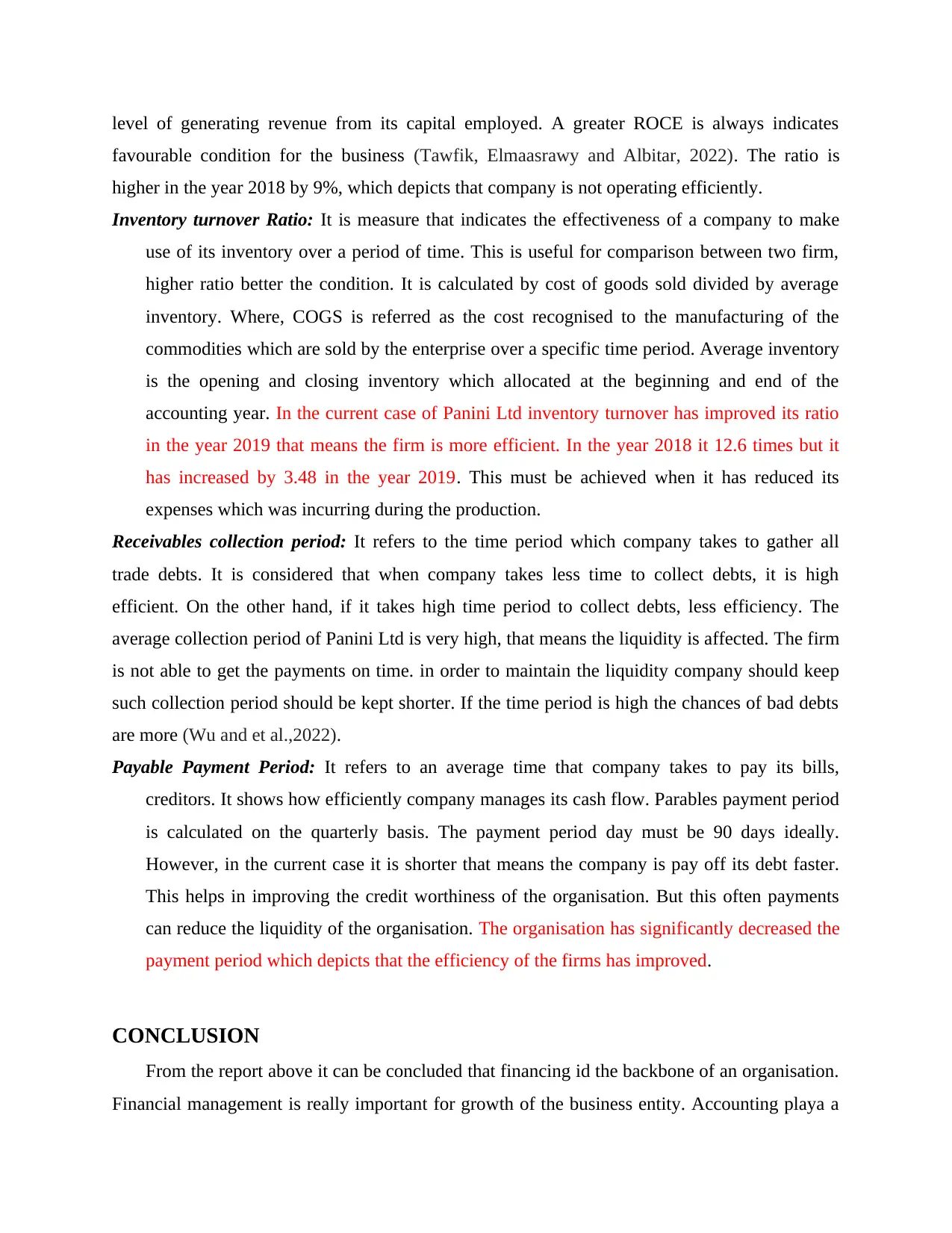
level of generating revenue from its capital employed. A greater ROCE is always indicates
favourable condition for the business (Tawfik, Elmaasrawy and Albitar, 2022). The ratio is
higher in the year 2018 by 9%, which depicts that company is not operating efficiently.
Inventory turnover Ratio: It is measure that indicates the effectiveness of a company to make
use of its inventory over a period of time. This is useful for comparison between two firm,
higher ratio better the condition. It is calculated by cost of goods sold divided by average
inventory. Where, COGS is referred as the cost recognised to the manufacturing of the
commodities which are sold by the enterprise over a specific time period. Average inventory
is the opening and closing inventory which allocated at the beginning and end of the
accounting year. In the current case of Panini Ltd inventory turnover has improved its ratio
in the year 2019 that means the firm is more efficient. In the year 2018 it 12.6 times but it
has increased by 3.48 in the year 2019. This must be achieved when it has reduced its
expenses which was incurring during the production.
Receivables collection period: It refers to the time period which company takes to gather all
trade debts. It is considered that when company takes less time to collect debts, it is high
efficient. On the other hand, if it takes high time period to collect debts, less efficiency. The
average collection period of Panini Ltd is very high, that means the liquidity is affected. The firm
is not able to get the payments on time. in order to maintain the liquidity company should keep
such collection period should be kept shorter. If the time period is high the chances of bad debts
are more (Wu and et al.,2022).
Payable Payment Period: It refers to an average time that company takes to pay its bills,
creditors. It shows how efficiently company manages its cash flow. Parables payment period
is calculated on the quarterly basis. The payment period day must be 90 days ideally.
However, in the current case it is shorter that means the company is pay off its debt faster.
This helps in improving the credit worthiness of the organisation. But this often payments
can reduce the liquidity of the organisation. The organisation has significantly decreased the
payment period which depicts that the efficiency of the firms has improved.
CONCLUSION
From the report above it can be concluded that financing id the backbone of an organisation.
Financial management is really important for growth of the business entity. Accounting playa a
favourable condition for the business (Tawfik, Elmaasrawy and Albitar, 2022). The ratio is
higher in the year 2018 by 9%, which depicts that company is not operating efficiently.
Inventory turnover Ratio: It is measure that indicates the effectiveness of a company to make
use of its inventory over a period of time. This is useful for comparison between two firm,
higher ratio better the condition. It is calculated by cost of goods sold divided by average
inventory. Where, COGS is referred as the cost recognised to the manufacturing of the
commodities which are sold by the enterprise over a specific time period. Average inventory
is the opening and closing inventory which allocated at the beginning and end of the
accounting year. In the current case of Panini Ltd inventory turnover has improved its ratio
in the year 2019 that means the firm is more efficient. In the year 2018 it 12.6 times but it
has increased by 3.48 in the year 2019. This must be achieved when it has reduced its
expenses which was incurring during the production.
Receivables collection period: It refers to the time period which company takes to gather all
trade debts. It is considered that when company takes less time to collect debts, it is high
efficient. On the other hand, if it takes high time period to collect debts, less efficiency. The
average collection period of Panini Ltd is very high, that means the liquidity is affected. The firm
is not able to get the payments on time. in order to maintain the liquidity company should keep
such collection period should be kept shorter. If the time period is high the chances of bad debts
are more (Wu and et al.,2022).
Payable Payment Period: It refers to an average time that company takes to pay its bills,
creditors. It shows how efficiently company manages its cash flow. Parables payment period
is calculated on the quarterly basis. The payment period day must be 90 days ideally.
However, in the current case it is shorter that means the company is pay off its debt faster.
This helps in improving the credit worthiness of the organisation. But this often payments
can reduce the liquidity of the organisation. The organisation has significantly decreased the
payment period which depicts that the efficiency of the firms has improved.
CONCLUSION
From the report above it can be concluded that financing id the backbone of an organisation.
Financial management is really important for growth of the business entity. Accounting playa a
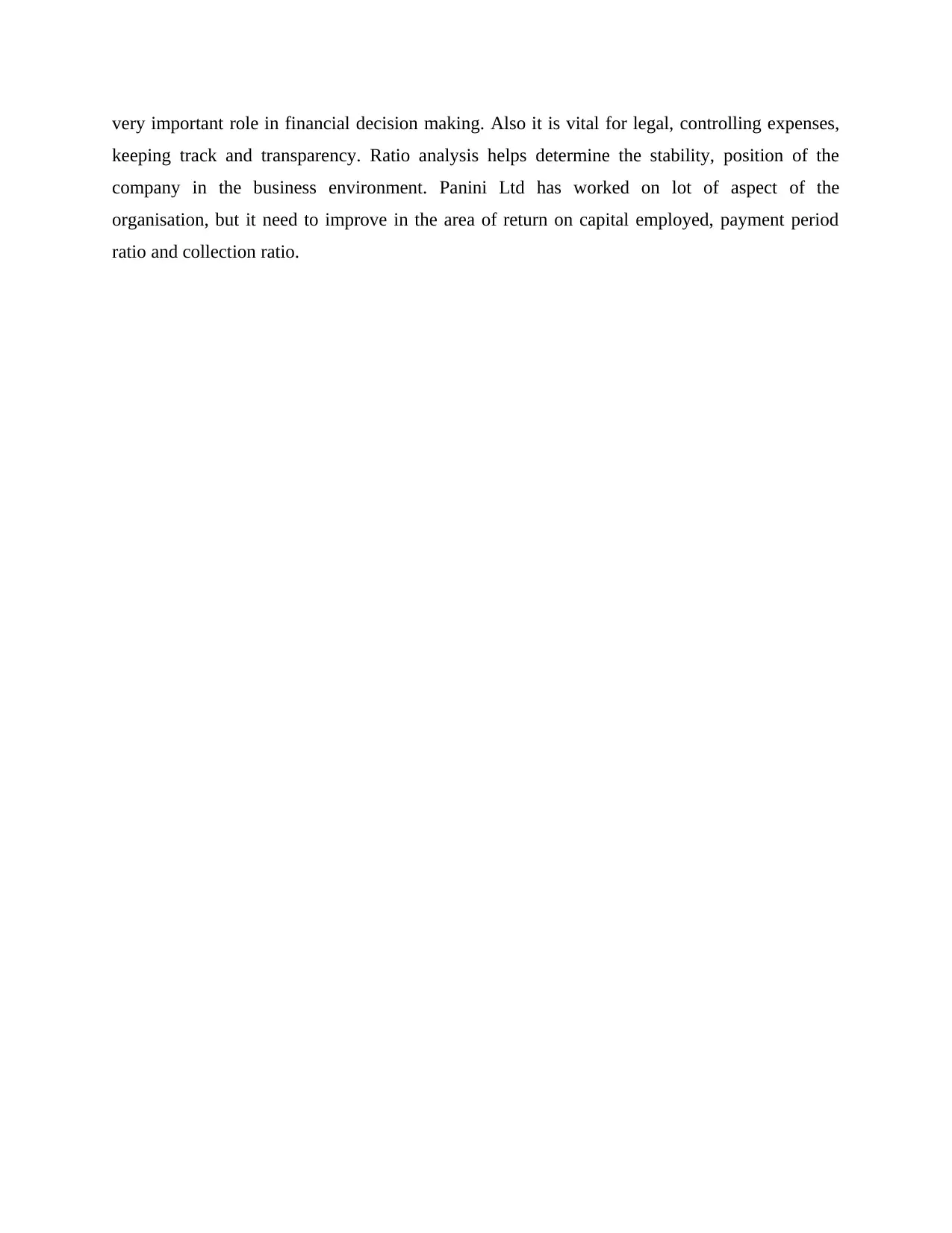
very important role in financial decision making. Also it is vital for legal, controlling expenses,
keeping track and transparency. Ratio analysis helps determine the stability, position of the
company in the business environment. Panini Ltd has worked on lot of aspect of the
organisation, but it need to improve in the area of return on capital employed, payment period
ratio and collection ratio.
keeping track and transparency. Ratio analysis helps determine the stability, position of the
company in the business environment. Panini Ltd has worked on lot of aspect of the
organisation, but it need to improve in the area of return on capital employed, payment period
ratio and collection ratio.
⊘ This is a preview!⊘
Do you want full access?
Subscribe today to unlock all pages.

Trusted by 1+ million students worldwide
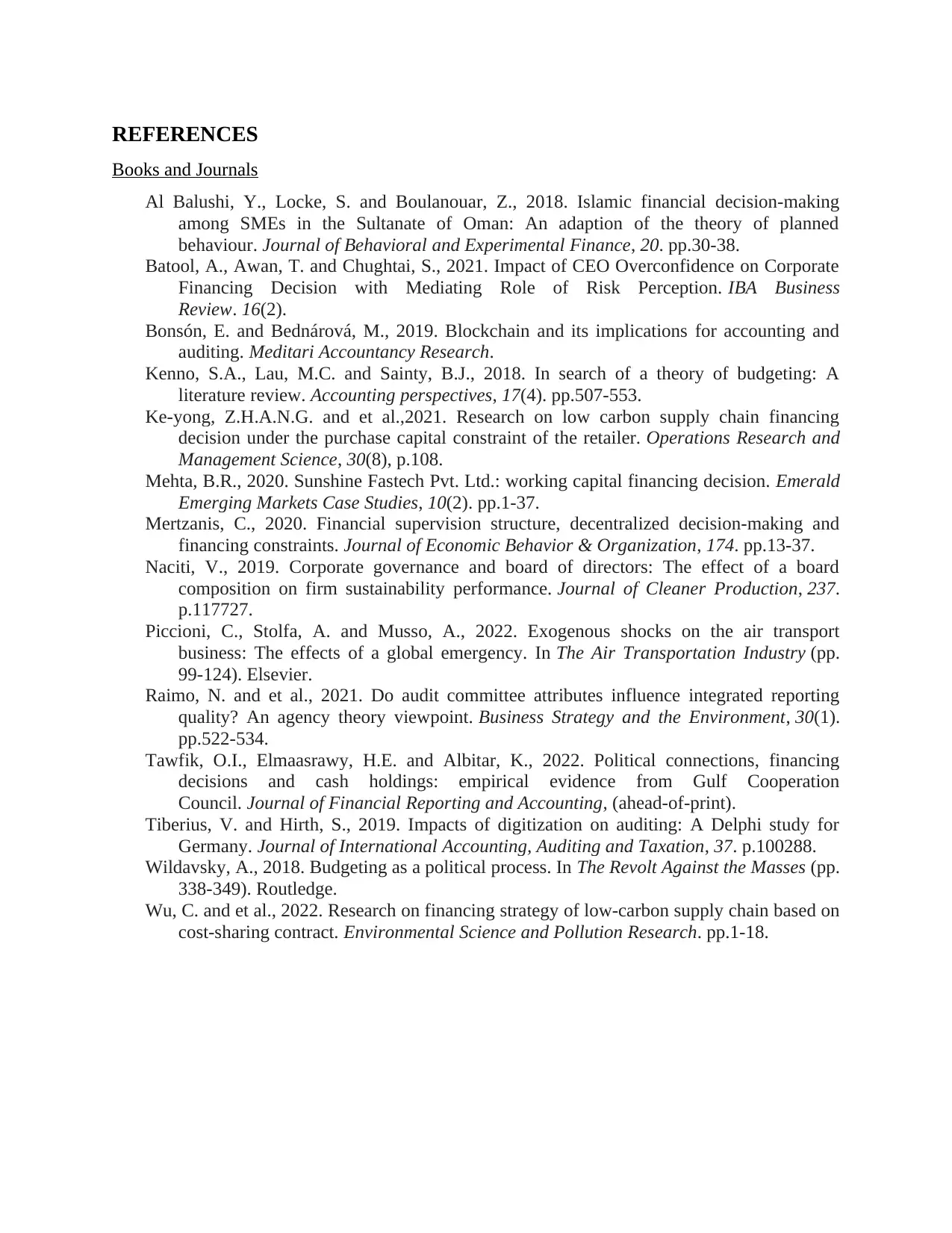
REFERENCES
Books and Journals
Al Balushi, Y., Locke, S. and Boulanouar, Z., 2018. Islamic financial decision-making
among SMEs in the Sultanate of Oman: An adaption of the theory of planned
behaviour. Journal of Behavioral and Experimental Finance, 20. pp.30-38.
Batool, A., Awan, T. and Chughtai, S., 2021. Impact of CEO Overconfidence on Corporate
Financing Decision with Mediating Role of Risk Perception. IBA Business
Review. 16(2).
Bonsón, E. and Bednárová, M., 2019. Blockchain and its implications for accounting and
auditing. Meditari Accountancy Research.
Kenno, S.A., Lau, M.C. and Sainty, B.J., 2018. In search of a theory of budgeting: A
literature review. Accounting perspectives, 17(4). pp.507-553.
Ke-yong, Z.H.A.N.G. and et al.,2021. Research on low carbon supply chain financing
decision under the purchase capital constraint of the retailer. Operations Research and
Management Science, 30(8), p.108.
Mehta, B.R., 2020. Sunshine Fastech Pvt. Ltd.: working capital financing decision. Emerald
Emerging Markets Case Studies, 10(2). pp.1-37.
Mertzanis, C., 2020. Financial supervision structure, decentralized decision-making and
financing constraints. Journal of Economic Behavior & Organization, 174. pp.13-37.
Naciti, V., 2019. Corporate governance and board of directors: The effect of a board
composition on firm sustainability performance. Journal of Cleaner Production, 237.
p.117727.
Piccioni, C., Stolfa, A. and Musso, A., 2022. Exogenous shocks on the air transport
business: The effects of a global emergency. In The Air Transportation Industry (pp.
99-124). Elsevier.
Raimo, N. and et al., 2021. Do audit committee attributes influence integrated reporting
quality? An agency theory viewpoint. Business Strategy and the Environment, 30(1).
pp.522-534.
Tawfik, O.I., Elmaasrawy, H.E. and Albitar, K., 2022. Political connections, financing
decisions and cash holdings: empirical evidence from Gulf Cooperation
Council. Journal of Financial Reporting and Accounting, (ahead-of-print).
Tiberius, V. and Hirth, S., 2019. Impacts of digitization on auditing: A Delphi study for
Germany. Journal of International Accounting, Auditing and Taxation, 37. p.100288.
Wildavsky, A., 2018. Budgeting as a political process. In The Revolt Against the Masses (pp.
338-349). Routledge.
Wu, C. and et al., 2022. Research on financing strategy of low-carbon supply chain based on
cost-sharing contract. Environmental Science and Pollution Research. pp.1-18.
Books and Journals
Al Balushi, Y., Locke, S. and Boulanouar, Z., 2018. Islamic financial decision-making
among SMEs in the Sultanate of Oman: An adaption of the theory of planned
behaviour. Journal of Behavioral and Experimental Finance, 20. pp.30-38.
Batool, A., Awan, T. and Chughtai, S., 2021. Impact of CEO Overconfidence on Corporate
Financing Decision with Mediating Role of Risk Perception. IBA Business
Review. 16(2).
Bonsón, E. and Bednárová, M., 2019. Blockchain and its implications for accounting and
auditing. Meditari Accountancy Research.
Kenno, S.A., Lau, M.C. and Sainty, B.J., 2018. In search of a theory of budgeting: A
literature review. Accounting perspectives, 17(4). pp.507-553.
Ke-yong, Z.H.A.N.G. and et al.,2021. Research on low carbon supply chain financing
decision under the purchase capital constraint of the retailer. Operations Research and
Management Science, 30(8), p.108.
Mehta, B.R., 2020. Sunshine Fastech Pvt. Ltd.: working capital financing decision. Emerald
Emerging Markets Case Studies, 10(2). pp.1-37.
Mertzanis, C., 2020. Financial supervision structure, decentralized decision-making and
financing constraints. Journal of Economic Behavior & Organization, 174. pp.13-37.
Naciti, V., 2019. Corporate governance and board of directors: The effect of a board
composition on firm sustainability performance. Journal of Cleaner Production, 237.
p.117727.
Piccioni, C., Stolfa, A. and Musso, A., 2022. Exogenous shocks on the air transport
business: The effects of a global emergency. In The Air Transportation Industry (pp.
99-124). Elsevier.
Raimo, N. and et al., 2021. Do audit committee attributes influence integrated reporting
quality? An agency theory viewpoint. Business Strategy and the Environment, 30(1).
pp.522-534.
Tawfik, O.I., Elmaasrawy, H.E. and Albitar, K., 2022. Political connections, financing
decisions and cash holdings: empirical evidence from Gulf Cooperation
Council. Journal of Financial Reporting and Accounting, (ahead-of-print).
Tiberius, V. and Hirth, S., 2019. Impacts of digitization on auditing: A Delphi study for
Germany. Journal of International Accounting, Auditing and Taxation, 37. p.100288.
Wildavsky, A., 2018. Budgeting as a political process. In The Revolt Against the Masses (pp.
338-349). Routledge.
Wu, C. and et al., 2022. Research on financing strategy of low-carbon supply chain based on
cost-sharing contract. Environmental Science and Pollution Research. pp.1-18.
1 out of 10
Related Documents
Your All-in-One AI-Powered Toolkit for Academic Success.
+13062052269
info@desklib.com
Available 24*7 on WhatsApp / Email
![[object Object]](/_next/static/media/star-bottom.7253800d.svg)
Unlock your academic potential
Copyright © 2020–2025 A2Z Services. All Rights Reserved. Developed and managed by ZUCOL.


